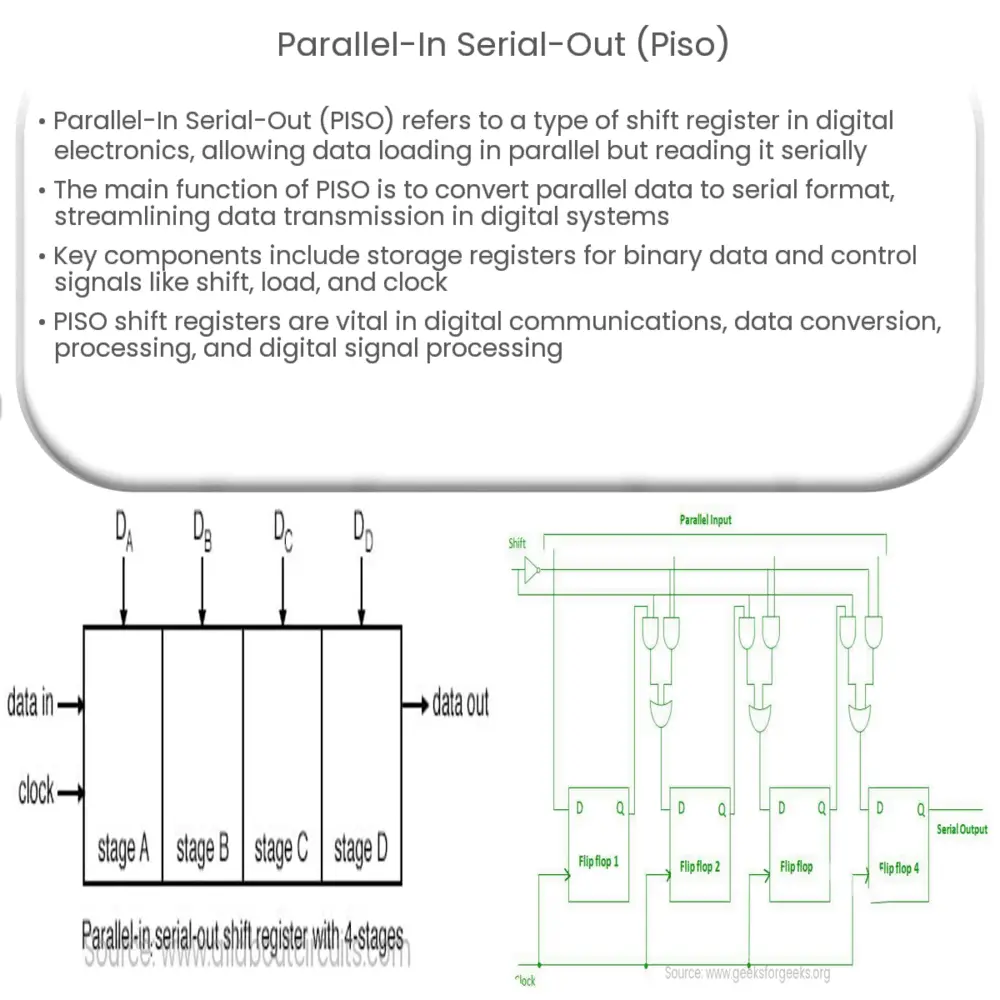Explore the fundamentals of Parallel-In Serial-Out (PISO) shift registers, their operations, and varied applications in digital electronics.

Understanding Parallel-In Serial-Out (PISO)
Parallel-In Serial-Out, often abbreviated as PISO, refers to a type of shift register, a storage device, in the field of digital electronics. This technology allows data entry or ‘loading’ in parallel format, but the data extraction or ‘reading’ is done serially, i.e., one bit at a time.
Functionality of PISO Shift Registers
The primary function of a PISO shift register is to convert data from a parallel format to a serial format. This conversion proves essential in numerous digital systems as it aids in reducing the complexity and the number of required lines for data transmission, making the process more efficient.
Key Components of a PISO Shift Register
- Storage registers: These are used to hold the binary data (bits) that are loaded in parallel form.
- Control signals: These include signals like shift, load, and clock signals that control the operations of the shift register.
Operations of a PISO Shift Register
A PISO shift register’s operations can be classified into two main types: the parallel load operation and the shift right operation.
- Parallel Load Operation: This is the phase where multiple data bits are loaded into the shift register simultaneously. During this operation, the load signal is activated.
- Shift Right Operation: After the parallel load operation, the shift right operation begins. Here, the data is shifted right, one bit at a time, and is read out in a serial manner. The shift operation is controlled by the clock signal.
It’s worth noting that the operations’ sequence – parallel loading followed by serial shifting – is crucial in the overall functioning of the PISO shift register.
Applications of PISO Shift Registers
PISO shift registers play a vital role in numerous applications across various fields. These include digital communications, data conversion and processing, and digital signal processing.
The next section will delve deeper into the working mechanism of PISO shift registers, providing a step-by-step walkthrough of the process. Additionally, it will detail specific applications and advantages of this technology.
Detailed Working Mechanism of PISO Shift Registers
Let’s walk through the working of a PISO shift register:
- Initialization: At the start, all internal flip-flops of the shift register are cleared. The parallel data to be loaded is presented at the data inputs.
- Parallel Load: On activating the load control signal, the data from the inputs is loaded into the flip-flops simultaneously. This is the parallel loading operation.
- Shift Right: Once the data is loaded, the shift control signal is activated. This triggers the shift right operation. With each pulse of the clock signal, the data is shifted one bit position to the right.
- Serial Output: As the data shifts right, it is serially output from the rightmost bit position. The output is produced at the clock rate, resulting in a serialized data stream.
Applications of PISO Shift Registers
Due to their unique data handling capability, PISO shift registers are commonly used in a variety of digital systems:
- Data Transmission: They’re integral in the conversion of parallel data into serial for transmission over a communication channel.
- Digital Signal Processing: PISO registers are used in digital filters, where large sets of parallel data must be processed sequentially.
- Data Storage: PISO registers are used in memory systems for storing data in parallel and then retrieving it in a serial manner.
Conclusion
In summary, Parallel-In Serial-Out (PISO) shift registers are indispensable tools in digital electronics. They are used to convert parallel data into a serial format, simplifying data transmission and reducing the required wiring in digital systems. The loading of parallel data and the serial extraction of the same through a process of shifting encapsulates the operation of PISO shift registers.
From digital communications to signal processing and data storage, the applications of PISO registers are extensive and varied. As digital technology continues to evolve, the importance of these registers and their operational principles is expected to remain paramount, underlining the necessity for a solid understanding of their functionality.

